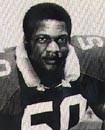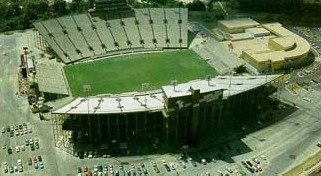
Bobby Bowden
By Bill Bunker
01/2004
This is the fifth in a multi-part series on the history of Seminole Boosters, Inc., written by former FSU Sports Information Director Bill Bunker.
Gridiron success spurs Booster building boom
Florida State expanded Doak S. Campbell Stadium to 40,500 seats in 1964 to force Florida into a home and home schedule arrangement. For 14 years thereafter, the steel-girdered "Erector Set" on Pensacola Street demanded little more than the occasional coat of paint. Capacity crowds appeared in even numbered years for the Florida game, but the Seminoles managed a victory only in the Gators' first trip to Tallahassee.
In 1978, Seminoles Boosters, Inc., despite the objections of Athletic Director John Bridgers expanded the stadium to 46,500 seats, beginning a building program that hasn't stopped since. Imbued with the confidence of a rejuvenated organization hitting its stride and freshly armed with a Board of Regents charter as an Independent Direct Support Organization for FSU, Seminole Boosters, Inc. borrowed money to get the job done.
 |
Bobby Bowden |
FSU's 10-2 record in 1977 under second-year coach Bobby Bowden, which included the first victory over Florida in nine years, gave impetus to the project.
"We felt we needed to expand the stadium even though the athletic director didn't think we could afford it," said Seminole Boosters President Andy Miller, then three years into the job as the group's executive director. "The Seminole Booster board, at that point, with Bobby Bowden starting to win, felt we had to get out of the small-stadium, no-conference, no-tradition cycle we were in. We felt we had to do something dramatic to get this thing going. We felt like we could sell the seats, so we stepped up to the plate and financed that expansion."
The Boosters also expanded the concessions and restrooms, both in 1978 and again in 1979. As the university became more aware of the value of an aggressive, efficient direct support organization unencumbered by state spending regulations, the Boosters were assigned other responsibilities and properties, such as ownership and renovation of Coble Terrace, where student athletes were housed, and all stadium concessions and gift shop operations.
Having survived a rocky apprenticeship, Miller was ready for independence. "I'm glad I had those early years, because I learned how people acted when we were losing on the field," he said. "I didn't do a very good job at first. I wanted to, but just didn't know how. I relied a lot on George Langford, who, more than anyone else, is the reason I made it. George was a good fundraiser who took me under his wing and taught me the ropes. One of the big things he said early in the process was, 'You can't sell a sinking ship. People don't want to know about deficits, they don't want to give to a lost cause. They want you to create exciting programs for them to participate in. Let's sell what's exciting in the future.'"
With that mission in hand, Miller and his new assistant executive director, Charlie Barnes, moved into a two-bedroom apartment/office at Coble Terrace. "In order to get to our desks, we had to unplug the copy machine, but it was there that we started running our own organization," Miller said.
The transition was not an easy one. There were questions within and without the organization as to whether an independent booster club was appropriate, and there was entrenched opposition from Bridgers who wanted the athletic department to control the activities and spending of the boosters. In his autobiography, Bridgers cites FSU President Bernie Sliger's refusal to give him control of the boosters as one reason he left FSU. Recently, from retirement in Pensacola, Bridgers said: "The Boosters wanted to do a building program we couldn't afford. They tried to do more than they were capable of."
But, under Sliger's leadership, wheels were beginning to turn and gears were meshing. Recognizing that Bowden's success would attract offers from other schools, Sliger, with the financial support of the Boosters and FSU Foundation, orchestrated a new five-year contract with renewal and extension clauses that took effect at the end of each year. Included were buyout provisions for both the school and the coach.
"We may have been the first university to do that," Bowden said. "When Auburn tried to hire me in 1980, I told them it would cost them $780,000 just to get me out of my contract. The (Auburn) president told me to go ahead and take the job and they would fight it out in court, but I wasn't interested."
One of Sliger's more popular moves among Seminole Boosters was his appointment of his chief assistant, Phil Fordyce, as interim athletic director when Bridgers resigned in December, 1979. Earlier that year, as Sliger's liaison man with both the athletic department and the Boosters, Fordyce located an on-campus house on Wildwood Drive and convinced the university to make it available for Booster headquarters.
Fordyce occupied the AD's chair for 13 months, until C. W. "Hootie" Ingram assumed the position in January 1981. During his brief tenure as athletic director, Fordyce greatly advanced the Boosters' vision of building facilities rather than funding athletic department operations. Largely through the efforts of Fordyce, the legislature approved funding for a new fieldhouse which, would become the Coyle E. Moore Athletic Center. Campbell stadium was expanded again, and new scoreboard and lights were installed. The baseball stadium, tennis courts, locker rooms and other facilities received long-needed upgrades and facelifts. He brought the computer age to FSU athletics and revamped administrative procedures.
"Phil Fordyce was a tremendous AD," Miller said. "He may not have fit the image people expected of an athletic director, but he went in and got the funding to build Moore Athletic Center from the legislature. Also, about that time we took over the licensing program from the university business office, and it's been a moneymaker for us ever since. After Phil left as AD, we actually made him our licensing director and he moved that program big strides forward. He was valuable to us as the interim AD, and later as licensing director he really helped us organize that program."
The spark that ignited the building boom was Bobby Bowden's Seminoles football team. In the five years prior to his arrival FSU won 19 games while losing 37. In Bowden's first five seasons the Seminoles record was 45-14, including four straight victories over Florida, two Orange Bowl appearances, and two top-ten rankings. At last, FSU's athletic department was producing the type of income it needed to pay its bills, making Booster money available for physical improvements.
 |
Ron Simmons |
The 1980 team, which Bowden still considers one of his strongest, defeated third-ranked Nebraska and fourth-ranked Pittsburgh on successive weekends. Only one-point losses to Miami and Oklahoma in the Orange Bowl prevented a second straight undefeated regular season and possible national championship. FSU had captured the nation's attention, but, it would take a less successful season against overwhelming odds to drive the point home.
Bowden remembers it well: "Nineteen eighty-one. Oktoberfest, we called it. Even though we didn't go to a bowl that year, it was probably the year that transformed us. We played those five teams on the road back to back. We lost to Nebraska and we lost to Pitt, but then we beat Ohio State, Notre Dame and LSU. Won three out of five, but we were really beat up after that.
"We gave Miami a good game, but Southern Miss beat us badly at home. But, that was the year that attracted a lot of attention."
Seminole Boosters, Inc. acted quickly to take advantage of Florida State's rising prestige and popularity. In perhaps its most exciting and visionary project to date, a skybox was planned and constructed atop Campbell Stadium's east stands. With 200 seats on top and six individual boxes below, all selling for premium prices, the skybox became an instant revenue producer, raising $850,000 in 1982, its first year of operation.
Flexing its newfound financial muscle, the Boosters floated their first bond issue to finance both stadium and other athletic department projects, including the Coyle E. Moore Athletic Center, which opened in 1982. That same year, a new 5,000-seat baseball stadium was built, and the Doak Campbell Stadium was expanded to 55,246 seats, an increase of almost 15,000 seats in five years.
 |
Doak Campbell Stadium - 1982 |
During the late 1970s and early '80s, Florida State became a national leader in women's sports under Barbara Palmer, a 1970 graduate who had become women's athletic director in 1977. The late Herb Morgan provided the legislative leadership to pass a sweeping legislative package that helped all Seminole athletics, but was particularly beneficial to women's sports in response to the Federal Title IX program. The Booster also responded to a need in '79, hiring Debbie Mason Derzypolski as a full-time fund raiser for women's athletics.
The populations of Tallahassee and Florida State both increased during this period of rapid expansion, but together they couldn't fill the new stadium seats that appeared almost annually. Fortunately, the roads to Tallahassee got better as interest in the Seminoles grew, prompting the creation and growth of local clubs throughout Florida. Florida Senate President Jim King was a leader and pioneer in establishing the Jacksonville club, traditionally one of the largest and most active, and in 1982, served as the Boosters' Areas' Leader, providing expertise and advice to area clubs.
Bowden's spring golf and banquet tour, organized and conducted by Barnes, has helped the clubs grow. His willingness to contribute his time, coupled with his winning personality and his teams' winning ways have been a big part of Seminole Boosters' success.
"When Charlie (Barnes) came in we really escalated the whole club network," Miller said. "Coach Bowden had done these dinners and golf tournaments in West Virginia. Charlie set up that first network of Bobby Bowden golf days and dinners, and now it's become very much a tradition. When I talk to my counterparts from other universities, they ask how in the world do we get our coach to do that for us. They are just astounded, because they say they could never get their coach to give them that much time. Bobby Bowden has been just a tremendous guy to work with."
Bowden, who enjoys his springtime jaunts, returns the compliment. "Charlie Barnes has made these tours work," he said. "Remember now, I've been traveling with him for 26 years, up and down this state, night after night, year after year. You can't do that with just anybody. It has been a perfect fit.
"And, I enjoy our boosters. When you've done this as long as I have you meet a lot of people, and they mean a lot to me. I'm just glad to see them. Many of them are just like family."
Bowden's extended family raised $1 million for the first time under President Bob Camp in 1979. Hurley Booth added a half million more in 1980, then Jim Carter brought in $2 million in 1981. Skybox revenues added to John Olson's $2.2 million in direct contributions bringing the total to $3 million.
Lomax Smith in 1983 and Tom Barron in '84 posted increases. In 1985, when George Langford returned for a third term as president, total revenues were $3.3 million and Campbell Stadium seated 60,000.
Seminoles Boosters, Inc. was now recognized as one of the top athletic funds raisers in the country. In 1986, Clearwater's Bill Parker became the first Booster president, now called National Chairman, elected from outside the Tallahassee area. A new, and even more exciting, era was about to begin.
Next: Spinning dynasties and castles in the air.